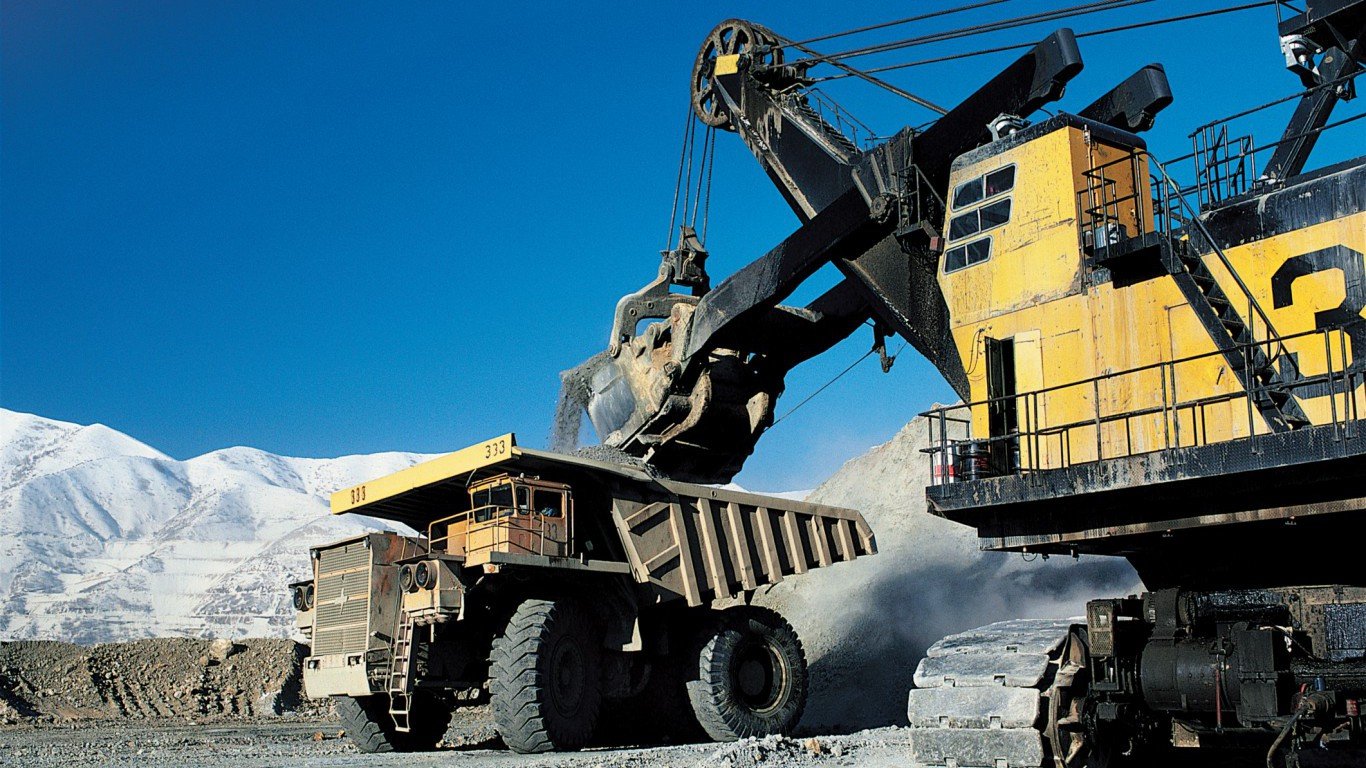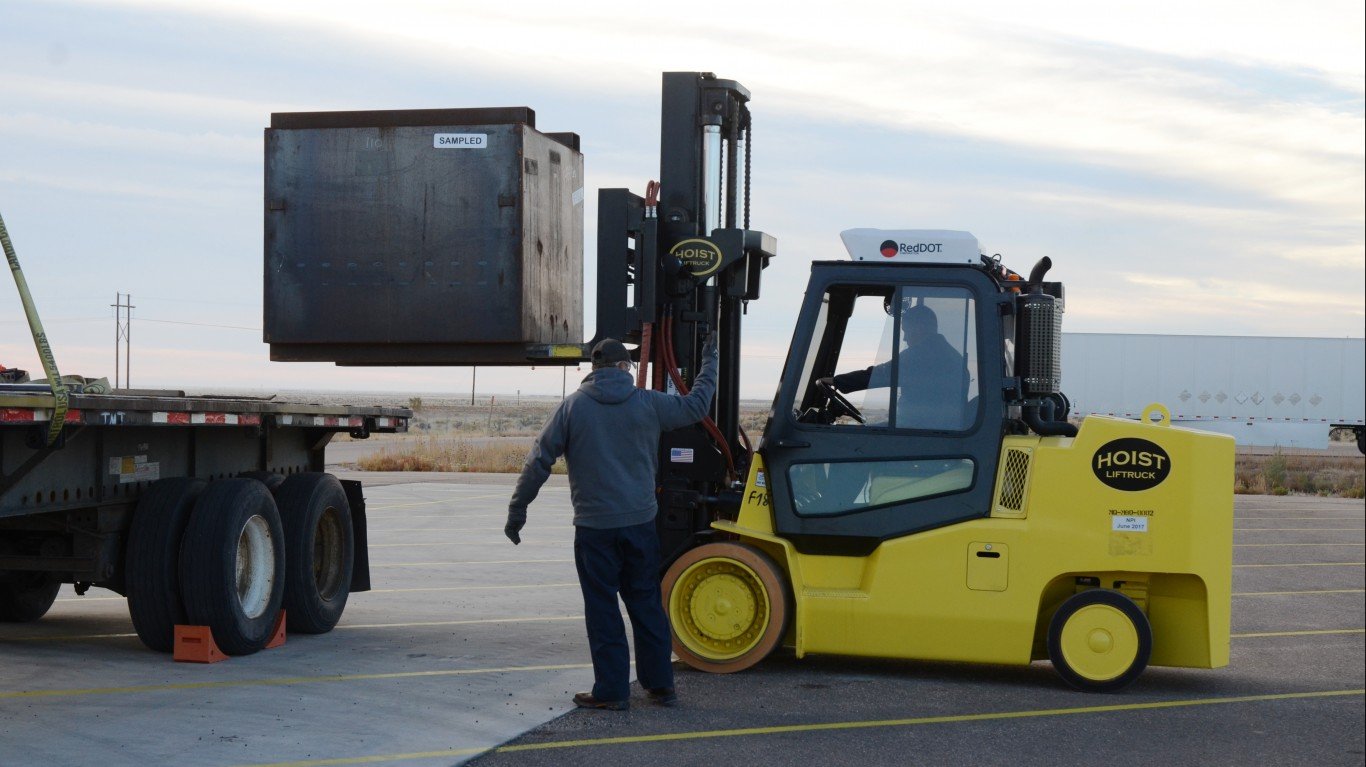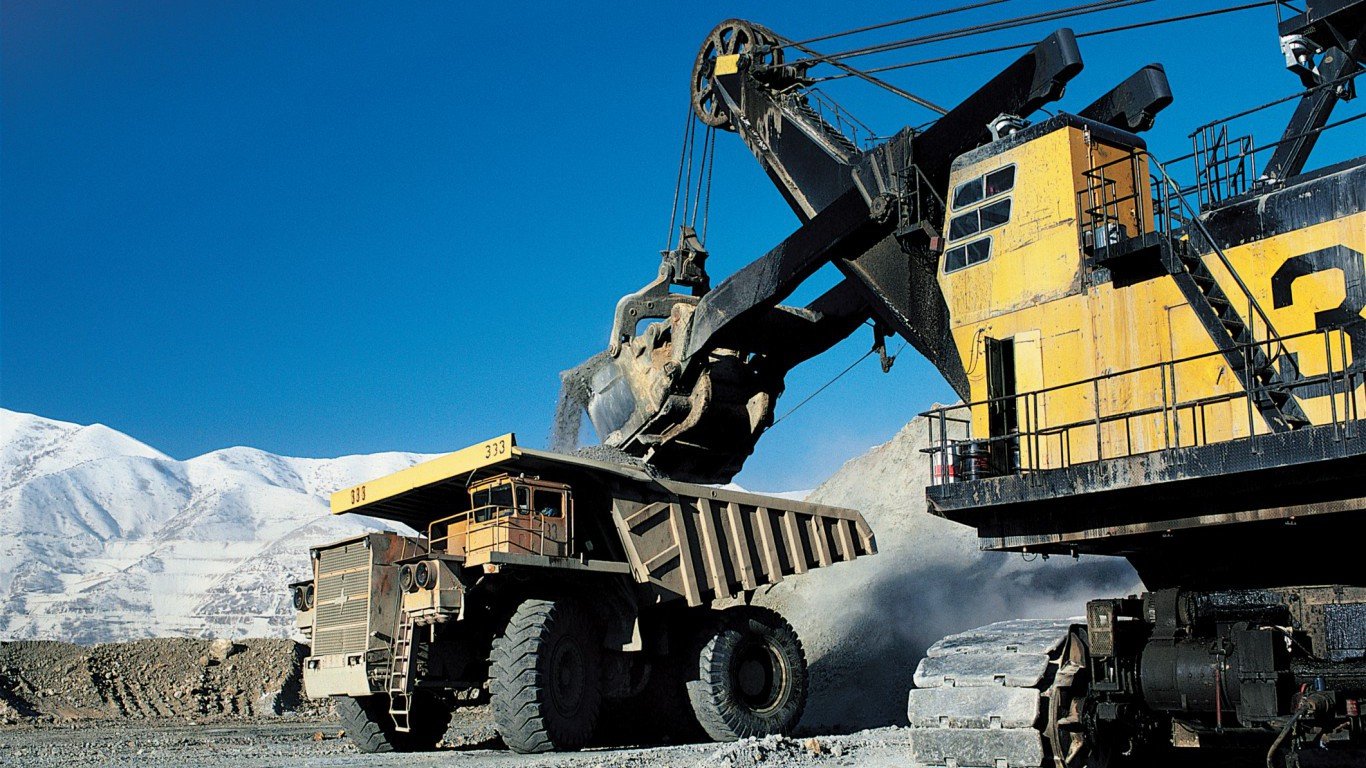
There were 5,250 fatal job-related injuries in 2018, according to the Bureau of Labor Statistics, a slight increase from the previous year. While no job is completely free of risk, most jobs are relatively safe. Yet there are quite a few professions that are far more dangerous, and where the risk of dying is more than 10 times higher compared to the average American occupation.
To determine the 25 most dangerous jobs in America, 24/7 Wall St. reviewed fatal injury rates for 71 occupations from the Bureau of Labor Statistics’ Census of Fatal Occupational Injuries program. These occupations are ranked based on the number of fatal accidents in 2018 per 100,000 full-time equivalent workers.
These dangerous jobs often involve the use of heavy machinery and frequently take place in perilous locations, like on top of a building or out in the remote wilderness.
In spite of the hazards these workers face every day, many of them are not highly compensated. Most of the jobs on this list have a median annual wage of less than $41,000. The danger these jobs pose, coupled with the low pay, have made many of these occupations some of the least desirable professions in the country. These are the worst jobs in America.
Some of the most dangerous jobs could soon be a thing of the past as improvements in technology means many of these jobs could soon be automated. Jobs such as long haul truck driving and logging could soon be replaced by self-driving trucks. While automating these jobs would help reduce injuries and fatalities, it could also put many workers out of a job — and these job losses will take a much greater toll on certain parts of the country than others. These are the cities that will lose the most jobs to automation.
Click here to see the 25 most dangerous jobs in America
Click here to read our methodology
25. Industrial truck and tractor operators
> 2018 fatal injury rate: 6.8 per 100,000 workers
> Total injuries in 2018: 44 fatal injuries, 4,970 nonfatal injuries
> Most common cause of fatal accident: Transportation incidents
> Median annual wage: $34,750
Industrial truck and tractor operators generally move materials in places like warehouses, construction sites, or factories using equipment like forklifts or trucks. The job typically requires precise control and coordination as accidents can result in serious injury and sometimes death. There were 44 work-related fatalities among industrial truck and tractor operators in 2018, or 6.8 for every 100,000 people working in the profession. The most common cause of death was a transportation incident, such as a collision.
Other potential hazards, like overexertion, trips and falls, and unintentional contact with objects or equipment also caused thousands of nonfatal injuries in 2018.
[in-text-ad]
24. Athletes, coaches, umpires, and related workers
> 2018 fatal injury rate: 7.6 per 100,000 workers
> Total injuries in 2018: 22 fatal injuries, 1,090 nonfatal injuries
> Most common cause of fatal accident: Transportation incidents
> Median annual wage: $33,530
Being an athlete, coach, umpire, or referee may not be what many think of as a dangerous job. Such jobs, however, can often require a lot of travel, and travelling can be dangerous. There were 22 work-related deaths of athletes, coaches, umpires, and related workers in 2018, and 18 of those fatalities were attributable to a transportation incident, like a motor vehicle accident.
Serious injury in this line of work has other, far more common, causes. Overexertion or bodily reactions like sprains, tears, and soreness, for example, accounted for nearly half of the 1,090 injuries among Americans in this line of work in 2018.

Source: fstop123 / Getty Images
23. Heating, air conditioning, and refrigeration mechanics and installers
> 2018 fatal injury rate: 8.5 per 100,000 workers
> Total injuries in 2018: 40 fatal injuries, 6,900 nonfatal injuries
> Most common cause of fatal accident: Falls, slips, trips
> Median annual wage: $28,530
Heating, air conditioning, and refrigeration mechanics and installers typically work in uncomfortable conditions, including cramped spaces and dealing with high heat or low temperatures. Workplace hazards can include, but are not limited to, electrocution, burns, muscle strain, and injuries associated with lifting heavy equipment. Falls, slips, and trips accounted for the largest share of the 40 workplace fatalities in the occupation in 2018, but overexertion and bodily reaction accounted for the largest share of nonfatal injuries.

Source: AzmanJaka / Getty Images
22. Electricians
> 2018 fatal injury rate: 8.8 per 100,000 workers
> Total injuries in 2018: 80 fatal injuries, 6,350 nonfatal injuries
> Most common cause of fatal accident: Exposure to harmful substances or environments
> Median annual wage: $55,190
Electricians fix and install power systems in a variety of settings, often working with dangerous voltage. In 2018, 80 electricians died and more than 6,300 were injured while on the job. Nearly half of these fatalities resulted from exposure to harmful substances or environments, which includes electrocution. Electricians, who sometimes work well above ground, were also injured and even killed by slips, trips, and falls. They also must travel frequently between locations and face hazards related to transportation such as car accidents.
[in-text-ad-2]

Source: welcomia / Getty Images
21. Bus and truck mechanics and diesel engine specialists
> 2018 fatal injury rate: 9.5 per 100,000 workers
> Total injuries in 2018: 39 fatal injuries, 3,610 nonfatal injuries
> Most common cause of fatal accident: Contact with objects and equipment
> Median annual wage: $47,350
These mechanics work to upgrade or repair large vehicles with diesel engines. The vehicles, as well as the objects the mechanics need to work on them, present a serious hazard — 17 people in this field were killed in 2018 due to contact with the objects or equipment associated with this occupation. Other causes of death include fires and explosions, as well as slips and falls. Among all American jobs considered, diesel mechanics have the ninth highest rate of nonfatal injuries that cause missed work, with over 1,400 incidents per 100,000 workers.

Source: ilkercelik / Getty Images
20. Operating engineers and other construction equipment operators
> 2018 fatal injury rate: 10.6 per 100,000 workers
> Total injuries in 2018: 39 fatal injuries, 2,280 nonfatal injuries
> Most common cause of fatal accident: Transportation incidents
> Median annual wage: $47,810
Construction zones can be particularly hazardous work environments, and people operating heavy equipment, such as bulldozers, front end loaders, scrapers, and derricks, are at relatively high risk of serious injury while on the job. Hazardous job site conditions can include falling objects, other workers operating equipment, and utility lines. Partially as a result, following safety procedures is a central component of this job. There were 39 fatal injuries and 2,280 nonfatal but serious injuries among Americans working in this occupation in 2018.
Pay for this occupation is slightly higher than average. The typical full-time worker in the field earns $47,810 a year, about $9,000 more than the median wage across all occupations.
[in-text-ad]
19. Mining machine operators
> 2018 fatal injury rate: 11.0 per 100,000 workers
> Total injuries in 2018: 9 fatal injuries, 370 nonfatal injuries
> Most common cause of fatal accident: Contact with objects and equipment
> Median annual wage: $52,700
Mining has long been one of the most dangerous occupations in the world, as it entails working far underground in potentially unstable tunnels with coal dust or other highly combustible materials. Some of the worst workplace disasters in history have been mine collapses or explosions. Today, improved safety regulations and technology have drastically reduced the likelihood of death on the job, but mining is still highly dangerous. Mining machine operators suffer a fatality rate over three times the national rate.

Source: franckreporter / Getty Images
18. Maintenance and repair workers, general
> 2018 fatal injury rate: 12.5 per 100,000 workers
> Total injuries in 2018: 64 fatal injuries, 21,130 nonfatal injuries
> Most common cause of fatal accident: Contact with objects and equipment
> Median annual wage: $38,300
Maintenance and repair workers fix and maintain machinery and buildings. This can involve a wide range of tasks, including, but not limited to, repairing or replacing circuit breakers, general cleaning and upkeep of buildings and properties, troubleshooting and diagnosing problems, and assembling equipment and machinery. Work can be hazardous as maintenance and repair workers often work in uncomfortably hot or cold environments, in cramped spaces, or on top of ladders.
The largest share of the 64 fatal and 21,130 nonfatal injuries among repair and maintenance workers in 2018 occured due to contact with equipment and dangerous objects.

Source: Drazen_ / Getty Images
17. Construction laborers
> 2018 fatal injury rate: 13.0 per 100,000 workers
> Total injuries in 2018: 259 fatal injuries, 20,430 nonfatal injuries
> Most common cause of fatal accident: Falls, slips, trips
> Median annual wage: $35,800
Construction sites are among the most hazardous work environments, and construction laborers are far more prone to serious injury than most American workers. In a given day, a construction laborer may do a wide range of tasks, including moving materials, setting up scaffolding, digging trenches, and removing debris and other potential hazards from construction sites.
Because their work is often outdoors in all weather conditions — and sometimes at great heights — falls, slips, and trips accounted for the largest share of the 259 fatal injuries among construction laborers in 2018.
[in-text-ad-2]

Source: RyanJLane / Getty Images
16. Police and sheriff’s patrol officers
> 2018 fatal injury rate: 13.7 per 100,000 workers
> Total injuries in 2018: 108 fatal injuries, 380 nonfatal injuries
> Most common cause of fatal accident: Violence and other injuries by persons or animals
> Median annual wage: $61,380
Police and sheriff’s patrol officers are responsible for maintaining law and order and ensuring public safety, which often means interacting with dangerous and violent individuals. Over 100 police and sheriff’s patrol officers were killed in the line of duty in 2018. The majority of those fatalities were attributable to injuries inflicted by other people or animals.
Police work can also involve driving at high speeds, and many police deaths in 2018 were also due to transportation incidents, such as car accidents.

Source: kali9 / Getty Images
15. First-line supervisors of mechanics, installers, and repairers
> 2018 fatal injury rate: 15.1 per 100,000 workers
> Total injuries in 2018: 46 fatal injuries, 3,100 nonfatal injuries
> Most common cause of fatal accident: Violence and other injuries by persons or animals
> Median annual wage: $66,140
Maintenance and repair workers rank among the most dangerous jobs in the United States with a fatal injury rate of 12.5 per 100,000 workers, and those who supervise them are often at even greater risk of serious injury or death with a fatal injury rate of 15.1 per 100,000 workers. The largest share of fatal injuries among workers in the field happened due to violent interactions with other people or animals. The most common source of the 3,100 nonfatal injuries for people in this occupation in 2018 was inadvertent contact with dangerous objects and equipment.
[in-text-ad]

Source: skynesher / Getty Images
14. Helpers, construction trades
> 2018 fatal injury rate: 15.8 per 100,000 workers
> Total injuries in 2018: 11 fatal injuries, 3,460 nonfatal injuries
> Most common cause of fatal accident: Falls, slips, trips
> Median annual wage: $31,200
Construction zones can be among the most dangerous places to work in the United States — and the job of helpers in construction trades is one of several construction occupations to rank on this list. The job can require performing a range of physically demanding tasks in all weather conditions, often on scaffolding or ladders at great heights. Of the 11 deaths among construction site helpers in 2018, six were attributable to slips and falls. Over 1,000 nonfatal injuries were also attributable to slips and falls.

Source: valio84sl / Getty Images
13. Miscellaneous agricultural workers
> 2018 fatal injury rate: 18.0 per 100,000 workers
> Total injuries in 2018: 157 fatal injuries, 13,160 nonfatal injuries
> Most common cause of fatal accident: Transportation incidents
> Median annual wage: $24,600
Working on farms can include heavy equipment use and livestock management, which can be dangerous tasks — and miscellaneous agricultural workers are more likely to be killed by an accident at work than most American workers. Transportation incidents such as car accidents accounted for the largest share of fatal injuries on the job for miscellaneous agricultural workers in 2018, followed by inadvertent contact with equipment and other objects.
Compared to most other jobs on this list, miscellaneous agricultural workers are not paid much. The typical annual wage in the occupation is just $24,600, well below the $38,640 median across all occupations.

Source: wathanyu / Getty Images
12. Grounds maintenance workers
> 2018 fatal injury rate: 18.6 per 100,000 workers
> Total injuries in 2018: 225 fatal injuries, 13,030 nonfatal injuries
> Most common cause of fatal accident: Transportation incidents
> Median annual wage: $29,400
Grounds maintenance workers typically work outdoors, maintaining the landscape and grounds of homes, campuses, hotels, parks, and more. The work can be physically demanding and performed in all kinds of weather conditions. The work can be dangerous largely due to the type of equipment many grounds workers use regularly such as chain saws, pruners, and lawn mowers. Fatalities are commonly the result of accidents involving tree trimmers, which are effectively saw blades attached to long telescopic poles. Injuries due to falls are also relatively common in grounds keeping as some tasks are performed at great heights.
[in-text-ad-2]

Source: Shinyfamily / Getty Images
11. Electrical power-line installers and repairers
> 2018 fatal injury rate: 19.3 per 100,000 workers
> Total injuries in 2018: 29 fatal injuries, 1,490 nonfatal injuries
> Most common cause of fatal accident: Exposure to harmful substances or environments
> Median annual wage: $70,910
Electrical power-line installers and repairers set up and fix infrastructure such as electric power, telecommunication, and fiber optic cables. Because people in this occupation work around high voltage electric wires and often at considerable heights, the job ranks among the most dangerous in the United States. Electrical power-line installers and repairers sustained 1,490 serious injuries in 2018, and 29 people in the occupation were killed on the jobs.
Power line installation and repair is a highly skilled job, and partially as a result, it is high paying. The typical American working in the field earns just over $70,000 a year, well above the $38,640 median across all occupations.

Source: DGLimages / Getty Images
10. First-line supervisors of landscaping, lawn service, and groundskeeping workers
> 2018 fatal injury rate: 20.2 per 100,000 workers
> Total injuries in 2018: 48 fatal injuries, 1,990 nonfatal injuries
> Most common cause of fatal accident: Falls, slips, trips
> Median annual wage: $48,220
Groundskeeping ranks among the most dangerous jobs in the United States with a fatal injury rate of 18.6 per 100,000 workers, but their supervisors are often at even greater risk of serious injury or death. There were 48 job-related deaths of first-line supervisors of landscaping, lawn service, and groundskeeping workers in 2018, or 20.2 per 100,000 workers.
Such workers are often working from elevated positions, and the largest share of fatal injuries among workers in the field happened due to slips and falls. The job can also be physically demanding, and the most common source of the 1,990 nonfatal injuries for people in this occupation in 2018 was overexertion.
[in-text-ad]

Source: Cineberg / Getty Images
9. First-line supervisors of construction trades and extraction workers
> 2018 fatal injury rate: 21.0 per 100,000 workers
> Total injuries in 2018: 144 fatal injuries, 5,390 nonfatal injuries
> Most common cause of fatal accident: Transportation incidents
> Median annual wage: $65,230
Construction and extraction work can be relatively dangerous, and Americans in supervisory roles for such occupations are among the most likely to have a fatal accident at work compared to those in nearly any other occupation. There were 144 fatal work-related injuries among those in the occupation in 2018, or 21 per 100,000 workers.
Job responsibilities vary but often include inspection of work progress, work equipment, and safety measures to ensure full compliance. Injuries from falls, slips, and trips are the most common cause of serious injury and second most common cause of death on the job. The leading cause of death in the occupation is incidents involving transportation, like motor vehicle accidents.

Source: franckreporter / Getty Images
8. Structural iron and steel workers
> 2018 fatal injury rate: 23.6 per 100,000 workers
> Total injuries in 2018: 15 fatal injuries, 800 nonfatal injuries
> Most common cause of fatal accident: Falls, slips, trips
> Median annual wage: $53,970
Structural iron and steel workers have one of the most dangerous jobs in the United States. The work of installing structural support beams for buildings and bridges is not only physically demanding, but also hazardous as it is often done at great heights. There were 15 fatalities among structural iron and steel workers in 2018, with the largest share attributable to falls, slips, and trips.
The job frequently involves the use of cranes and other lifting equipment as well as torches and welding machines. Mistakes with such equipment can result in serious injury, and the largest share of the 800 injuries reported in the field in 2018 came as a result of unintentional contact with equipment or objects.

Source: RichLegg / Getty Images
7. Farmers, ranchers, and other agricultural managers
> 2018 fatal injury rate: 24.7 per 100,000 workers
> Total injuries in 2018: 257 fatal injuries, 280 nonfatal injuries
> Most common cause of fatal accident: Transportation incidents
> Median annual wage: $67,950
Farmers, ranchers, and others working in agriculture often work with large animals and potentially dangerous machinery. In this line of work, people are subject to injuries from animals, transportation incidents, and contact with dangerous equipment — each of which caused dozens of fatalities in 2018. The 257 fatal injuries suffered by agricultural workers is the third highest total among all professions that year.
[in-text-ad-2]

Source: kali9 / Getty Images
6. Driver/sales workers and truck drivers
> 2018 fatal injury rate: 26.0 per 100,000 workers
> Total injuries in 2018: 966 fatal injuries, 78,520 nonfatal injuries
> Most common cause of fatal accident: Transportation incidents
> Median annual wage: $38,800
Driver/sales workers and truck drivers work in one of the largest fields in the U.S. economy, with over 3 million workers. Because such drivers spend hours on the road hauling cargo, many of the injuries and deaths are transportation-related. Truck drivers have one of the total number of fatal injuries at 966 and one of the highest totals of nonfatal injuries as well, at over 78,000.

Source: vm / Getty Images
5. Refuse and recyclable material collectors
> 2018 fatal injury rate: 44.3 per 100,000 workers
> Total injuries in 2018: 37 fatal injuries, 1,490 nonfatal injuries
> Most common cause of fatal accident: Transportation incidents
> Median annual wage: $37,260
Refuse and recyclable material collectors had a 2018 fatal injury rate of 44.3 deadly incidents per 100,000 workers. The job is one of just five with a fatal injury rate that is 10 times that of the rate for all jobs, which is 3.5 incidents per 100,000 workers. As refuse collectors spend their days traveling around neighborhoods, transportation incidents are the most common cause of fatal injuries in this job. The job has many other hazards — like falls, overexertion, and contact with equipment — that occur more often but are not as likely to be fatal.
[in-text-ad]

Source: Jens_Lambert_Photography / Getty Images
4. Roofers
> 2018 fatal injury rate: 51.5 per 100,000 workers
> Total injuries in 2018: 96 fatal injuries, 2,060 nonfatal injuries
> Most common cause of fatal accident: Falls, slips, trips
> Median annual wage: $39,970
Roofing is one of just four professions in which the fatal injury rate exceeded a rate of 50 deadly incidents per 100,000 full-time equivalent workers in 2018. The work of installing or replacing roofs is often done at considerable heights, increasing the risk of being seriously injured and worse by a fall. In fact, 74 of the 96 fatal accidents roofers suffered on the job were classified as falls, slips, and trips. Roofers are also subject to harmful environments as they often work long days in the hot sun, risking heat stroke.

Source: MatusDuda / Getty Images
3. Aircraft pilots and flight engineers
> 2018 fatal injury rate: 58.9 per 100,000 workers
> Total injuries in 2018: 70 fatal injuries, 490 nonfatal injuries
> Most common cause of fatal accident: Transportation incidents
> Median annual wage: $115,670
The most common injuries for aircraft pilots and flight engineers are transportation related. For pilots involved in any sort of crash, injuries can easily be fatal. The work of a pilot can be extremely taxing due to both mental stress and demanding scheduling, and exhaustion is a risk. These risks, however, are well rewarded, with the median annual wage being nearly three times the median for all occupations.

Source: Ales-A / Getty Images
2. Fishers and related fishing workers
> 2018 fatal injury rate: 77.4 per 100,000 workers
> Total injuries in 2018: 30 fatal injuries
> Most common cause of fatal accident: Transportation incidents
> Median annual wage: N/A
Fishers and related fishing workers had one of the highest rates of fatal injury in 2018. Commercial fishing is a largely physical work that involves fishing nets, gear, and slippery decks. Fishers and related fishing workers can also be exposed to challenging environmental factors such as extreme weather. In addition, workers may be out on the water or working from a remote area when an accident occurs, and where easy access to a hospital or medical professional may not be readily available. The majority of fatalities among fishers and related fishing workers are due to drowning.
[in-text-ad-2]

Source: stockstudioX / Getty Images
1. Logging workers
> 2018 fatal injury rate: 97.6 per 100,000 workers
> Total injuries in 2018: 56 fatal injuries, 1,040 nonfatal injuries
> Most common cause of fatal accident: Contact with objects and equipment
> Median annual wage: $40,650
With nearly 100 fatal injuries per 100,000 workers, logging is by far the most dangerous job in America. Loggers work with dangerous tools like chainsaws and harvesters to cut down heavy trees, which can sometimes fall on the workers. Fatalities may also be higher among loggers because they often work in remote areas, far away from medical attention they might need. There were over 1,000 nonfatal logging injuries in 2018, nearly triple the total in 2017.
Methodology
To determine the 25 most dangerous jobs in America, 24/7 Wall St. analyzed fatal injury rates for 71 detailed occupations from the Bureau of Labor Statistics’ Census of Fatal Occupational Injuries program. Injury rates were calculated as the number of fatal occupational injuries per 100,000 full-time equivalent workers, where a full-time worker is equivalent to 2,000 hours worked by an employee during the calendar year, and are for 2018.
Data on the number of nonfatal occupational injuries and illnesses that involved days away from work in 2018 came from the BLS Survey of Occupational Injuries and Illnesses program and are for private industry only. Data on median annual wages and total employment came from the Occupational Employment Statistics program of the BLS and are current as of May 2018. We only considered occupations for at the finest level of detail, excluding those for which two NAICS codes were combined.
Sponsored: Attention Savvy Investors: Speak to 3 Financial Experts – FREE
Ever wanted an extra set of eyes on an investment you’re considering? Now you can speak with up to 3 financial experts in your area for FREE. By simply
clicking here you can begin to match with financial professionals who can help guide you through the financial decisions you’re making. And the best part? The first conversation with them is free.
Click here to match with up to 3 financial pros who would be excited to help you make financial decisions.
Thank you for reading! Have some feedback for us?
Contact the 24/7 Wall St. editorial team.


 24/7 Wall St.
24/7 Wall St.
 24/7 Wall St.
24/7 Wall St.


